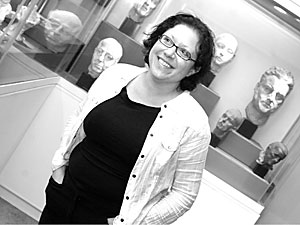 |
|
Jake Lacey/Arizona Daily Wildcat
|
Lisa Fischman is the new UA Museum of Art curator. She intends to bring an interdisciplinary approach to the position and is already working on a five-year calendar.
|
|
|
By Andrew O'Neill
Arizona Daily Wildcat
September 7, 2005
Print this
Her parents thought she might be a doctor someday. But Lisa Fischman abandoned her premedical studies after taking an art history class as an undergraduate at the University of Chicago.
Fischman said it was a course in still life and it set her future in motion.
"Your whole world expands," Fischman said about the class.
She said the professor taught students how to carefully "read" a visual image and that a single image can have layers of meaning.
She said she now looks at a variety of images in a different light, from artwork and photographs, to television and movies.
Since she assumed her position as chief curator for the UA Museum of Art in May, Fischman said she is intent on sharing her vision with the UA community.
"People assume that things in the museum are dead," she said.
Fischman said one of her priorities is to make the museum more user-friendly and accessible to the public.
To that end, she said the museum recently received a $150,000 grant from the Institute of Museum and Library Services, a government agency, which will be directed toward establishing digital images of the museum's collections on its Web site.
"Every object in here belongs to its public," Fischman said.
Fischman said one of the important aspects of her job is to be a scholar in terms of being able to figure out how the objects "speak" and how to bring contemporary works to that discussion.
"Being able to read artwork is like being able to read a book," she said.
Fischman said university museums in general have a unique opportunity to think about art in new ways because of a vibrant intellectual environment.
She said she uses an interdisciplinary approach to her work, having been trained in both art history and American studies.
Fischman said although she appreciates some of her profession's more orthodox ideas about art, these concepts can be applied in modern ways.
She said one of her goals is to understand the cultural conversation going on here in Tucson so that it might continue to be incorporated into the museum's exhibits.
Fischman's colleagues say they are impressed with her work so far, and they see great things in store for the museum.
"We wanted someone who saw art in a broader context and cultural environment," said Charles Guerin, executive director of the museum and a professor of art.
Guerin said he expects Fischman will work on some innovative projects for the museum in the future that will allow visitors to use the pieces to make connections to other academic subjects.
"People from any discipline can learn from this museum," Guerin said.
Fischman said she is working on a five-year calendar for planning exhibits and programs and continues to familiarize herself with the intellectual history of the museum.
She said she is also working on new ways to address the issue of diversity at the museum, both in terms of visitors, and the artists whose works are on display.
Fischman said she is excited about her position and being in Tucson is quite an adventure.
Perhaps the medical profession's loss is the art world's gain.
"I tell my parents I am a doctor," Fischman said. "Just not that kind of doctor."
There will be a "Meet the New Curator" gathering tomorrow from 2 p.m. to 2:45 p.m. at the UA Museum of Art, 1031 N. Olive Road.
